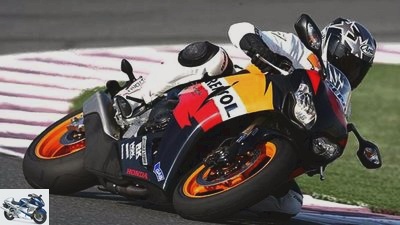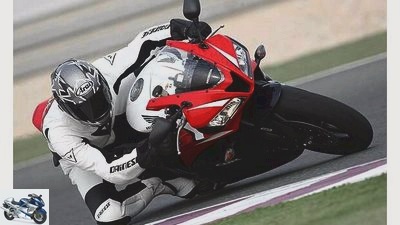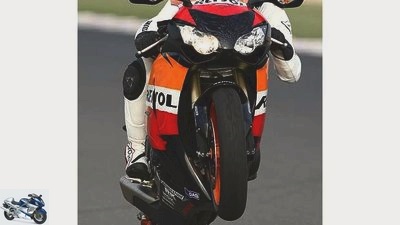Table of contents
- Premiere Honda CBR 600 RR / Fireblade with C-ABS ABS with racing license
- ABS with racing license
- ABS, brakes and chassis
- Conclusion

Buenos dias
motorcycles
Premiere Honda CBR 600 RR / Fireblade with C-ABS
Premiere Honda CBR 600 RR / Fireblade with C-ABS
ABS with racing license
Content of
Honda’s super sports bike CBR 600 RR and Fireblade will be launched in 2009 with an optional anti-lock braking system suitable for the race track. In Qatar, PS was able to put the new C-ABS through its paces.
Robert luck
02/18/2009
ABS with racing license
A nightmare comes true: the first two super sports cars with ABS hit the market! Purists, racing drivers and yesterday’s people are already rolling up their toenails, forumists will formulate hate mails to Honda. After all, ABS is no good on motorcycles, and every moderately trained and talented athlete driver brakes better than these technical bells and whistles. Quiet blood guys, take it easy. The days when the average motorcyclist would slow down an ABS at any time are long gone. And the times when an average pilot was better than an ABS in a panic braking on slippery surfaces never existed.
The crux of anti-lock braking systems has always been that the brake feel on the lever, which sports drivers want, has not been achieved. It always seemed spongy, you never really knew how far you were from the control area. If the ABS started with the regulation, the pulsation in the brake lever and the overall very rough regulation bothers you. That is now largely history, because Honda was the first manufacturer in the world to take on the needs of sports drivers and developed the C-ABS, with which there is no longer any pulsation or stuttering. Only the not very sporty, because spongy pressure point of the system is to be criticized. Basically the C-ABS differs from CBR 600 RR not like that of the Fireblade: The system costs 1000 euros extra on both motorcycles and adds 10 kilograms of weight. The mode of operation and components are identical; the software of the control unit is logically tailored to the vehicle. There are only minor hardware differences on the front axle, because two 320 millimeter brake discs are installed on the blade, where the 600 sister gets by with 310 discs.
ABS, brakes and chassis

Buenos dias
Not very fancy: the matt paneling of the CBR 600 RR conceals the ABS components.
The 10 kilograms of additional weight that the system brings with it cannot be felt on the racetrack without a direct comparison with a non-ABS bike. That is certainly also due to the characteristics of the Losail race track, because it doesn’t have really tight chicanes. But the ABS can show what it’s made of in high-speed braking zones: On the Fireblade, at the braking point at the end of the start / finish straight, the speedometer shows over 280 km / h. So straighten up and use the lever: if you apply the pads softly and then tighten them tightly, you won’t notice anything from the ABS, because like any other athlete, it is outside the control range. The already mentioned, somewhat creaky pressure point is not great, but still regulates the brakes well and their performance is beyond any doubt. It becomes more interesting when the driver pulls the lever without feeling, as in a shock braking: The blade first pulls itself into the springs at the back, so the stern dips a little before the system at the front decelerates the full cannon. If, as in Losail, small bumps come into play, the control range of the C-ABS is quickly reached.
A shock braking simulated on these bumps creates an impressive driving experience: On the bumps, the braking power is initially reduced in the control range, as if the brakes were losing their weight. So emotionally you fly far too fast towards the turn-in point, turn in with a slack stomach and subjectively too high a curve entry speed and leave the track area with the bumps in the process. The ABS, now no longer in the control range, immediately increases the braking power at about 15 degrees of inclination, which on the one hand raises the blade slightly and on the other hand leads to a really robust deceleration in an inclined position that one would never call up voluntarily. Since no pulsation can be felt in the entire braking system, this braking process feels like a world champion in a moderate lean angle and expands the horizon of experience. Even on the CBR 600 RR, which, unlike the Firebalde, rolls through life without a calming slipper clutch, the braking distance is not noticeably longer when the rear wheel starts to stamp after quick gear changes. In order to cope with the harder braking attacks, Honda increased the spring rate of the fork springs on both motorcycles by 5 percent. There is no doubt that the C-ABS can be a lifesaver in everyday use; that it can help hobby pilots on the racetrack to drive fast even in dry conditions, now too.
Conclusion

Buenos dias
ABS keeps your head free and ensures carefree braking and even more driving pleasure.
Conclusion: Okay, 1000 euros surcharge for the Honda anti-lock braking system is not a sticky stick. But anyone who has given up their super sports car recently knows that even a minor fall cannot be repaired for this sum. Overall, the C-ABS presented in Qatar on the CBR 600 RR and on the Fireblade was convincing across the board, as it barely acts, if at all, in normal racetrack operations and supports the driver in risky situations. It also keeps your head free, makes braking even easier and makes driving even more fun.
| Technical specifications |
Related articles
-
Traction control Ducati 1198S, C-ABS Honda Fireblade
K 28 pictures Honda 1/28 Honda 2/28 Honda 3/28 Honda 4/28 Honda 5/28 Honda 6/28 Honda 7/28 Honda 8/28 Honda 9/28 Honda 10/28 Honda 11/28 Honda 12/28…
-
Thyssenkrupp carbon rims for Honda CBR 1000 RR-R Fireblade
Thyssenkrupp accesories landing gear & Spring elements Thyssenkrupp carbon rims for Honda CBR 1000 RR-R Fireblade Thyssenkrupp Carbon rims for Honda CBR…
-
Jorg Kunstle motorcycles Top test Honda CBF 1000 Top test Honda CBF 1000 Fire day Amazing what can become of a super sports car. Honda combined the…
-
Ducati motorcycles Premiere Ducati 1198S Premiere Ducati 1198S Tap on!!! Content of If you open the gas early, you are faster faster. The crux of the…
-
Honda counselor Used purchase Used advice Honda CBF 600 Used advice Honda CBF 600 The golfing of the motorcycle The CBF 600 is a big step on the way to…
-
Second-hand advice on Honda VTR-1000 models
Gargolov counselor Used purchase Second-hand advice on Honda VTR-1000 models Second-hand advice on Honda VTR-1000 models Anti-diva 90-degree V2, classy…
-
Honda Gold Wing and Africa Twin with radar-based cruise control
Honda 10 pictures Honda 1/10 Honda can imagine many installation locations in the lush disguise of the Goldwing. The positions are clear at the front and…
-
archive counselor Used purchase Honda CBR 600 RR usage advice Advice on use of the Honda CBR 600 RR The 600 super sports car from Honda Content of It is…
-
Comparison test: Honda Hornet, Kawasaki Z 750, Suzuki GSR 600
Jahn motorcycles Comparison test: Honda Hornet, Kawasaki Z 750, Suzuki GSR 600 Comparison test: Honda Hornet, Kawasaki Z 750, Suzuki GSR 600 ABS shooters…
-
fact motorcycles Comparison test: Honda CBR 600 RR, Kawasaki ZX-6R, Suzuki GSX-R 600, Triumph Daytona 675, Yamaha YZF-R6 Comparison test: Honda CBR 600…